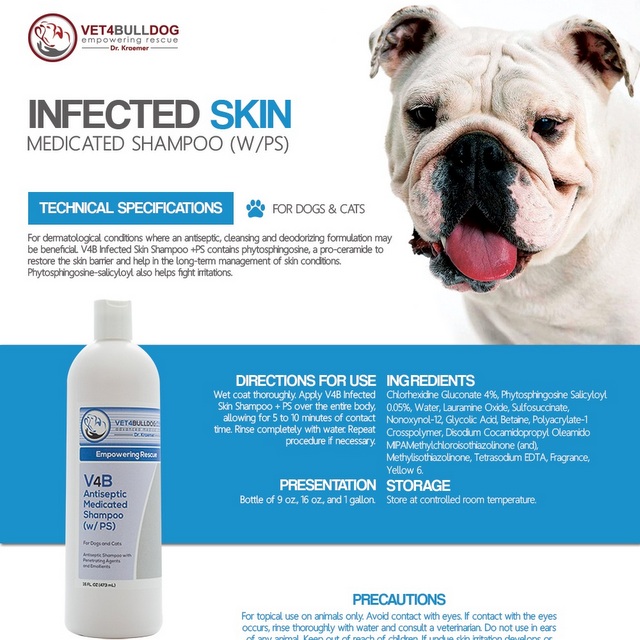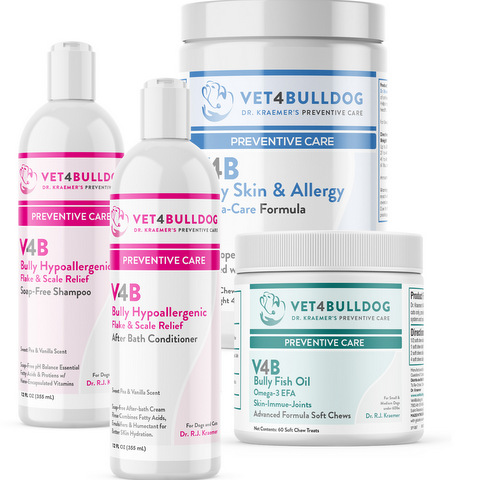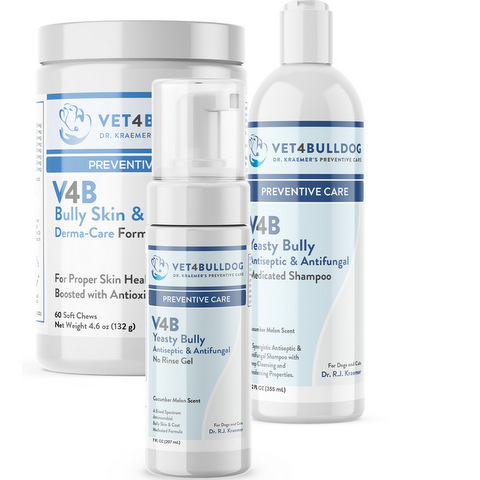Bulldog Chronic Ear Disease with MRSA
Hi Doctor, I'm at my wits end with my almost 5 yr old male Frenchie. He was always having ear infections and yeast infections. I always treated them immediately. Left ear canal ablation is done.
MRSA came back.
Now it's in his other ear.
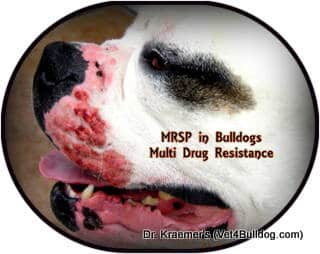
Bulldog Chronic Ear Disease with DRUG REACTION:
He was treated with Chloromphenical (spelling?) But had a terrible reaction to it and wound up trembling and sick and I had to take him to ER in Boston ma.
Now that it's in his other ear and he's not able to take Chloro, the only thing the vet can do is put Claro in his ear. It's not really doing the trick.
Bulldog Chronic Ear Disease with NATUROPATHIC TREATMENT:
I give him a plant-based antibiotic-resistant pill called Septocall that was given to him by a naturopathic Dr I see. It's kept it at bay but my Dr said to stop it to see if it worked. It didn't. Came back hard and he keeps scratching till his ears bleed. I stop him when I see him and put on his cone. But he's miserable.
Is there anything I can do to save my baby boy?
Nonresponsive Chronic Bulldog Ear Disease with MRSA
Dear Nbaer25,
Your primary objective should be to prioritize prevention over treatment.
Non-prescription therapeutics frequently demonstrate greater safety, cost-effectiveness, and, at times, superior efficacy compared to their prescription counterparts.
Nonresponsive Chronic Bulldog Ear Disease with MRSA- THE TRIFECTA:
Bulldogs lack a natural self-cleaning mechanism. Additionally, their ear canals are inherently narrower compared to most breeds. Compounding these factors is the breed's propensity for allergies, creating an unfortunate "bully ear disease trifecta" that makes bulldogs more susceptible to ear diseases than most other canine breeds.

BULLDOG EAR DISEASE TRIFECTA
- Absence of Self-Cleaning Mechanism in Ear Canals
- Abnormally Narrow Ear Canals
- The Breed's Susceptibility to Allergies
Nonresponsive Chronic Bulldog Ear Disease: PREVENTION & MAINTENANCE:
My Vet4Bulldog ear canal disease prevention and maintenance program involves weekly or biweekly cleaning, rinsing, and wiping.
BULLDOG EAR DISEASE PREVENTION MUST DO:
The fundamental and crucial aspects of preventive ear care involve routine cleaning, wiping, and rinsing.
It is imperative to manage allergies effectively and address any infection (otitis) at its earliest stage to prevent otitis from becoming a chronic and irreversible end-stage ear disease.

Nonresponsive Chronic Bulldog Ear with MRSP ANTIBIOTIC TREATMENT
Systemic antibiotics via oral or injectable routes are mostly required for bacteria that invade the medial and inner ear.
Bulldog Otitis Media and Otitis Interna Ear Infection:
Systemic antibiotics are often required for middle and inner ear infections due to the challenge of topical medications reaching these areas.
Bulldog Otitis Externa Ear Infection:
Topical antibiotics or antimicrobials are preferred for bulldog external ear disease, as the infection is localized to the outer ear canal and allows for direct application.
Systemic antibiotics are exclusively prescribed for cases of otitis media and otitis interna. In contrast, systemic antibiotics are seldom, if ever, necessary for cases of otitis externa.
Pet vs. Human Staph Multi-Drug Resistance Bacteria Infections:
The terms MRSA, MRSP, and multi-drug-resistant bacteria can trigger immediate alarm, conjuring images of aggressive, untreatable infections.
The "flesh-eating bacteria" scary news flash certainly doesn't help!
While it's important to be aware of these threats, it's also crucial to avoid unnecessary panic and understand the nuanced reality:
1. Not all bacteria are resistant
While some strains develop resistance to certain antibiotics, many bacterial infections remain treatable with existing medications.
2. Resistance levels and risks vary.
Different bacterial species demonstrate varying degrees of resistance to different antibiotics. MRSA and MRSP, while concerning, aren't nearly as prevalent as their media portrayal suggests.
Not all infections caused by these bacteria are severe or life-threatening.
3. Early diagnosis and appropriate treatment are key.
The key to combating antibiotic resistance and managing any bacterial infection is prompt diagnosis and proper treatment with the right antibiotic(s).
Completing the prescribed course of medication, and practicing good hygiene are crucial measures.
4. Responsible antibiotic use matters.
Overuse and misuse of antibiotics are major factors contributing to the development of resistance.
MRSA (Methicillin-resistant Staphylococcus aureus):
While common in human healthcare settings, MRSA is less frequent in pet infections.
MRSP (Methicillin-resistant Staphylococcus pseudintermedius)
Is the culprit in antibiotic-resistant staph infections in pets.
MRSA & MRSP Are both antibiotic-resistant strains of bacteria, but they differ in the species they affect
MRSA and MRSP Infection MYTH & FACT
Not all bacteria carrying specific resistance genes are inherently pathogenic.
Just like humans, dogs and other animals naturally harbor various bacterial communities on their skin, including Staphylococcus species.
BULLDOG SKIN AND EAR MRSP AND MRSA NORMAL MICROBIOME
Some of these MRSA and MRSP on your bulldog's skin and ear are harmless. may carry the mecA gene associated with methicillin resistance (defining MRSA and MRSP).
INCIDENTAL DIAGNOSIS:
At the time they are incidentally found on routine diagnostic tests, like culture swabs for unrelated skin issues, vets might incidentally detect MRSA or MRSP in apparently healthy animals. This doesn't necessarily imply an active infection or health risk.
It's crucial to acknowledge that the discovery of MRSA may be incidental and not the cause.
MRSP TRANSITION TO PATHOGENS
The key lies in distinguishing "colonization" from "infection." While carrying resistant bacteria, an animal might not exhibit any symptoms or pose a danger. Pathogenicity depends on various factors, like:
- VIRULENT/POTENT: Some MRSA/MRSP strains are more virulent than others.
- PET IMMUNE STATUS: Individual immune function and underlying health conditions play a role.
- SKIN BARRIER: Skin wounds, breaches in the barrier, or the presence of other infections can trigger pathogenic behavior.
Infections in pets are usually opportunistic and may result in wound infections or skin lesions.
MRSA AND MRSP PREANT & TREAT
- Avoid Overtreatment: treating colonized animals without evidence of infection risks unnecessary antibiotic use and contributes to resistance issues.
- Culture & Sensitivity Base: Only animals exhibiting clinical signs or at high risk should be treated, using specific antibiotics based on culture and sensitivity testing.
- Hygiene & Preventive Measures: Proper hygiene practices like handwashing and cleaning animal contact surfaces help prevent transmission and reduce environmental reservoirs.
- Topical Therapeutics: Often, topical antiseptic therapeutics are safer and more effective than systemic prescription medication
- V4B Bully Antiseptic XS Shampoo
- V4B Bully Antiseptic Gel
- V4B Bully Antiseptic Rinse & Spray
- V4B Bully Antiseptic Wipes
This concept has important implications for managing MRSA/MRSP in animals and minimizing unnecessary interventions:
MRSA COLONIZATION VS. INFECTION:
Understanding the distinction between colonization and infection, employing responsible antibiotic use, and implementing preventive measures are crucial for effectively managing these resistant bacteria in pets and beyond.

Infections in pets are usually opportunistic and may result in wound infections or skin lesions.
Bulldog MRSA & MRSP Skin and Ear Infection Topical Therapeutics
Topical antiseptic therapy is critical, safer, cheaper, and, at times, more effective than prescription medication.
Examples are Dr. Kraemer's V4B:
- Yeasty Bully Antiseptic Rinse
- Bully Hot-Spot Antiseptic Spray
- Bully Skinfold Antiseptic Wipes
- Bully Antiseptic No-Rinse Gel
Topical bully therapeutics are frequently paired with topical otic prescriptions.

Prescription medications are determined through cytology and cultures.
These prescriptions usually consist of a blend of an anti-inflammatory steroid, an anti-fungal agent, and an antibiotic.
Answer for Bulldog and French Bulldog Chronic Ear Disease with MRSA CHLORAMPHENICOL
Regarding your chloramphenicol statement, please be aware that administering oral chloramphenicol can be challenging due to its 8-hour pilling requirement. Keep in mind that both MRSA and MRSP treatment durations are much longer than for other infections. A few weeks of every few hours is nearly impossible for most pet owners.
As a more practical alternative, it can be compounded into a topical application.
Caution: Wearing gloves is essential when handling chloramphenicol.
Answer for Bulldog Chronic Ear Disease with MRSA: PROGNOSIS
Unfortunately, regardless of dedication and compliance, the current approach you are utilizing is unlikely to lead to a positive long-term result. At best, it may provide temporary palliative treatment.
I am concerned that your bulldog's ear canal may have progressed to irreversible end-stage disease. In such cases, the only lasting solution is a TECA with BO (total ear canal resection with Bulldog osteotomy).

Answer for Bulldog and French Bulldog Chronic Ear Disease with MRSA Pain Management:
Consider integrating pain management medications, such as NSAIDs and gabapentin, into the treatment plan.
Short-term steroids may also be considered, as they can help alleviate both itching and pain.
To confirm the end-stage status of the ear canal, sedation may be required for a thorough examination. Alongside assessing canal stenosis, the presence of polyps and tumors should be investigated. Utilizing tools like an ear video scope and imaging techniques such as CT scans is advisable.
BULLDOG TOTAL EAR CANAL RESECTION (TECA)
In instances of advanced ear disease, the epithelium lining typically demonstrates fibrous characteristics that frequently progress to the stage of calcification and ossification. In the later minimalized canal stages, any method other than total ear canal ablation (TECA) is generally viewed as palliative.
Your present treatment approach might offer false hope, deplete resources, and, most importantly, subject your pet to continuous pain and suffering.
The good news is as you already know TECA will stop the pain and solve the problem permanently.
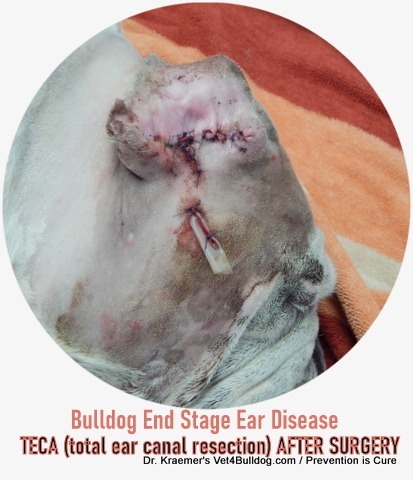
Best of luck,
Dr. Kraemer
Vet4Bulldog
Recommended by Owners Approved by Bulldogs
Please login or Register to submit your answer





